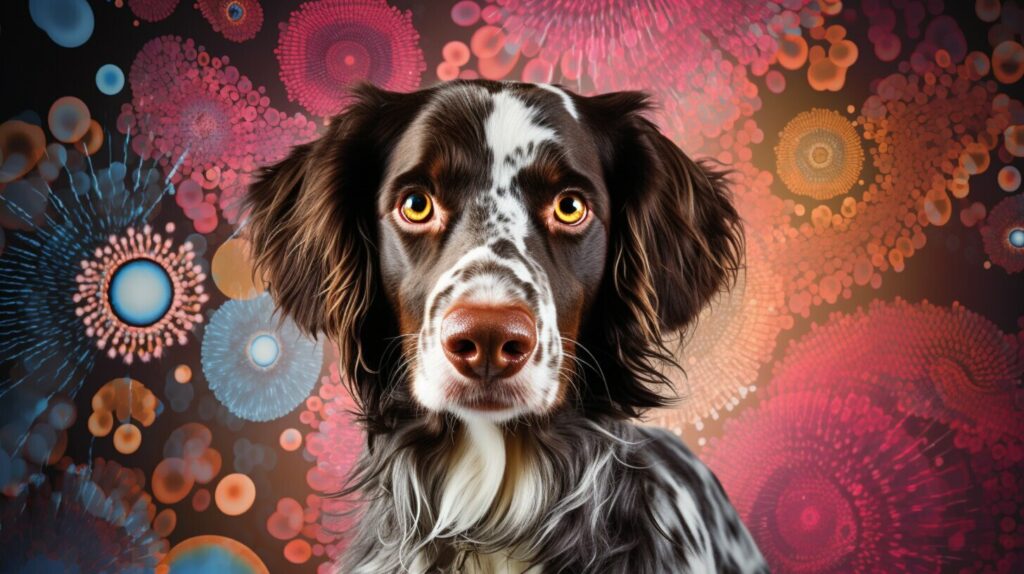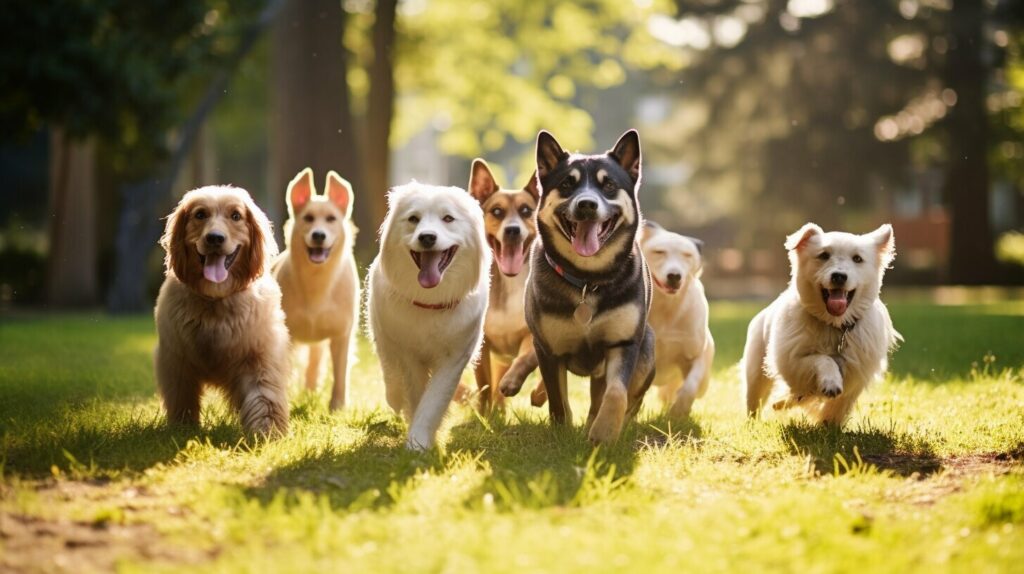If you are a dog lover, you may have heard about merle in dogs. Merle refers to a unique coat color pattern that is the result of a specific genetic mutation. This pattern can be seen in various dog breeds and creates a distinctive and stunning appearance.
Merle genetics can be complex and understanding how it works can help you better appreciate these beautiful animals. In this section, we will explore the key facts and insights about merle in dogs, including its genetic basis and its impact on coat color.
Key Takeaways:
- Merle is a unique coat color pattern found in certain dog breeds
- It is the result of a specific genetic mutation and can have various color variations
- Understanding merle genetics is crucial for responsible breeding practices and for the health and welfare of these dogs
The Merle Pattern: A Unique Coat Color Variation
The merle pattern is a unique coat color variation found in certain dog breeds. This pattern creates a marbled effect on the dog’s coat with patches of color on a lighter or white background. The merle pattern is caused by the merle gene, a dominant gene that affects the distribution of pigment in the hair shafts.
There are several variations of merle coat color, including blue merle, red merle, and chocolate merle. Blue merle is the most common variation and is often found in breeds such as the Australian Shepherd and Border Collie. Red merle is found in breeds such as the Australian Cattle Dog and Shetland Sheepdog, while chocolate merle is found in breeds such as the Chihuahua and Dachshund.
The merle pattern is most commonly found in breeds such as the Australian Shepherd, Border Collie, and Catahoula Leopard Dog. These breeds have been selectively bred to exhibit the merle pattern, and as a result, may have a higher prevalence of associated health issues.
The Merle Pattern in Different Dog Breeds
| Breed | Merle Pattern Variation |
|---|---|
| Australian Shepherd | Blue Merle, Red Merle |
| Border Collie | Blue Merle |
| Catahoula Leopard Dog | Blue Merle, Red Merle |
| Australian Cattle Dog | Red Merle |
| Shetland Sheepdog | Red Merle |
| Chihuahua | Chocolate Merle |
| Dachshund | Chocolate Merle |
It’s important to note that excessive breeding of merle dogs can result in a higher incidence of health issues such as vision and hearing problems, as well as possible increased sensitivity to anesthesia. Therefore, it’s crucial to ensure responsible breeding practices and genetic testing to minimize these risks.
In conclusion, the merle pattern is a unique and beautiful coat color variation found in certain dog breeds. However, it’s important to understand the genetics and potential health concerns associated with the merle gene to ensure the well-being of these dogs.
The Genetics of Merle: Understanding the Inheritance
Merle in dogs is a unique coat color pattern that is caused by a mutation in the SILV (Silver) gene. This gene regulates the production of melanin, which affects the pigmentation of a dog’s skin, hair, and eyes. The merle gene produces a distinctive dilution of pigment that results in a marbled or mottled coat pattern.
Merle is a dominant gene, meaning that if a dog inherits one copy of the merle gene from either parent, it will exhibit the merle pattern. Dogs that inherit two copies of the merle gene (one from each parent) may be born with a condition known as double merle, which can result in health problems such as blindness, deafness, and other developmental issues.
Aside from the coat pattern, the merle gene can also affect a dog’s eye color and pigmentation. Dogs with the merle gene may have blue or partially blue eyes, as well as white patches on their coat. It’s important to note that not all merle dogs will exhibit these traits, as they may be influenced by other genes.
While the merle pattern can give dogs a unique and striking appearance, it’s essential to understand the genetics behind it to avoid breeding-related health issues. Responsible breeders conduct genetic testing and avoid breeding dogs that carry two copies of the merle gene to prevent double merle puppies. By understanding the inheritance of the merle gene, you can ensure the well-being of these beautiful and unique dogs.
Merle in Different Dog Breeds
If you’re considering getting a merle dog, it’s important to understand the various breeds that commonly exhibit this coat pattern. Some of the most popular merle dog breeds include:
- Australian Shepherd
- Border Collie
- Chihuahua
- Dachshund
- Great Dane
- Shetland Sheepdog
While merle dogs are undeniably beautiful, it’s important to note that the merle gene can also be associated with some health concerns. Breeding two merle dogs together can result in a higher likelihood of deafness, blindness, and other health issues in their offspring. This is known as “double merle” breeding, and it’s important to avoid it in order to ensure the well-being of the puppies.
Responsible breeding is crucial when it comes to merle dogs. If you’re considering getting a merle puppy, it’s important to do your research and find a reputable breeder who conducts proper genetic testing and follows ethical breeding practices.
When it comes to owning a merle dog, it’s important to be aware of any potential health concerns associated with the merle gene. Regular veterinary checkups are necessary to ensure that your pet stays healthy. By taking proper precautions and providing appropriate care, you can enjoy the beauty and unique personality of your merle dog for years to come.
Merle Color Variations: Exploring the Spectrum
Merle coat color in dogs is a fascinating and complex topic, as the interplay between the merle gene and other coat color genes can create a wide range of unique patterns and shades. Here’s a closer look at some of the merle color variations that can be found in different dog breeds:
Blue Merle
One of the most common merle variations is the blue merle pattern, which features a dark gray or black coat with a light gray or white marbled effect. This pattern is often seen in breeds like the Australian Shepherd, Border Collie, and Dachshund.
Red Merle
The red merle pattern is similar to the blue merle, but with a reddish or tan base coat instead. This variation is often found in breeds such as the Australian Shepherd and Australian Cattle Dog.
Chocolate Merle
Less common than some of the other merle variations, the chocolate merle pattern features a brown coat with lighter brown or tan marbling. This pattern is found in breeds like the Great Dane and the Bulldog.
Harlequin Merle
The harlequin merle pattern is mostly seen in the Great Dane breed, and features a base coat of white with large black or gray spots. The merle gene can create a marbled effect within these spots, adding to the unique appearance of this pattern.
It’s important to note that while merle dogs can be strikingly beautiful, excessive breeding for this pattern can lead to health concerns such as deafness, blindness, and even skin cancer. Responsible breeding practices, including genetic testing and breeding for healthy traits, are crucial in ensuring the well-being of merle dogs.
Breeding Restrictions and Considerations for Merle Dogs
While merle dogs are undeniably beautiful and unique, it’s important to understand the breeding restrictions and considerations that come with this coat color pattern. Irresponsible breeding practices can lead to health concerns and ethical concerns surrounding the welfare of these animals.
One of the main concerns with merle breeding is the potential for health issues associated with excessive merle breeding. Two merle dogs should never be bred together, as this can result in homozygous merle offspring, which may be at risk for hearing and vision problems, as well as other health issues.
It’s crucial to ensure that merle dogs are bred responsibly, with a proper understanding of merle genetics and inheritance patterns. Genetic testing can play a vital role in determining whether a dog carries the merle gene and can help avoid the production of homozygous merles.
It’s also important to understand the potential health concerns associated with merle dogs. While not all merle dogs will experience health issues, merle-associated concerns may include hearing and vision problems, skin conditions, and increased susceptibility to certain diseases. Regular veterinary check-ups and proper care can help reduce the risk of health issues for merle dogs.
When considering breeding or adopting a merle dog, it’s essential to work with a responsible breeder or rescue organization. They can provide valuable guidance on the care and welfare of merle dogs and ensure that ethical breeding practices are followed.
Caring for a Merle Puppy: Special Considerations
If you’ve just welcomed a merle puppy into your home, you’re in for an exciting and unique experience. However, it’s important to keep in mind that merle genetics can come with some health concerns that require special attention. Here are some tips on how to care for your merle puppy:
Socialization
Like all puppies, merles need to be socialized early on to help ensure they become well-adjusted adult dogs. However, it’s especially important to be cautious with merles, who may be more prone to fearfulness and anxiety. Introduce your merle puppy to a variety of people, animals, and environments slowly and gradually, always keeping a close eye on their reactions. Avoid overwhelming your merle puppy with too much stimulation at once.
Training
Merles can be strong-willed and can benefit from consistent, positive reinforcement training. Use rewards such as treats, praise, and playtime to help your merle puppy learn obedience and good behavior. Be patient and persistent, but avoid punishment or harsh discipline, as this can create fear and mistrust in your puppy.
Health Care
Merles may be prone to certain health concerns, such as hearing and vision problems, and should be regularly checked by a veterinarian. Additionally, it’s important to monitor your merle puppy’s coat and skin for any signs of irritation or infection, as the merle gene can also affect pigmentation and hair growth. Regular grooming, including brushing and baths, can help keep your merle puppy’s coat healthy and clean.
Overall Considerations
Merle puppies can be a joy to care for, but it’s important to remember that they may require some extra attention due to their genetics. It’s crucial to only purchase your merle puppy from a reputable breeder who practices responsible breeding to help avoid potential health issues associated with excessive merle breeding. By providing a safe and loving environment, proper socialization and training, and regular health care, you can ensure that your merle puppy has a happy and healthy life.
Merle in Dogs: Beauty and Complexity Defined
Overall, merle is a fascinating pattern that adds unique beauty and complexity to the coat of a dog. Understanding the genetics behind merle is crucial for breeders and dog owners alike, as it can impact the health of these animals.
Merle in dogs is caused by a dominant gene that affects the distribution of melanin. This gene can also impact eye color and pigmentation, which is why it’s important for breeders to be aware of the potential health concerns associated with excessive merle breeding.
Despite the potential health concerns, merle dogs are beloved by many due to their stunning coat color variations and striking patterns. The merle pattern is truly unique and can be seen in a variety of breeds, from Border Collies to Great Danes.
As a dog owner, it’s important to provide proper care and attention to a merle puppy. This includes socialization, training, and health care specific to merle dogs. With responsible breeding practices and proper care, merle dogs can be healthy, happy companions for many years to come.
In summary, merle in dogs is a beautiful and complex trait that adds uniqueness to each dog breed that exhibits it. Understanding merle genetics and practicing responsible breeding is crucial to ensure the well-being of these amazing animals.
Conclusion
Congratulations, you now have a comprehensive understanding of merle in dogs. You have learned that the merle pattern is a unique coat color variation that is caused by a genetic mutation. This mutation affects pigmentation in the coat and can also affect eye color and hearing.
You also know that responsible breeding is crucial when it comes to merle dogs. Breeding two merle dogs together can result in offspring with serious health issues. It is important to work with a knowledgeable breeder who uses genetic testing, and to avoid breeding practices that prioritize coat color over the dog’s health.
If you are considering adding a merle puppy to your family, keep in mind that they require special care and attention. Socialization, training, and health care should all be tailored to the needs of a merle dog. But with the right knowledge and care, you can provide a loving home for a beautiful and unique merle dog.
Final Thoughts
Merle in dogs is a fascinating and complex topic. By understanding the genetic basis of the merle pattern, we can better appreciate the unique beauty of these dogs. However, we must also prioritize responsible breeding practices to ensure that merle dogs are healthy and happy. With this knowledge, we can provide the best care possible for our beloved merle pets.
FAQ
Q: What is merle in dogs?
A: Merle is a genetic pattern that affects the coat color of dogs. It creates a mottled or marbled appearance, with patches of color on a lighter base coat.
Q: How is the merle pattern inherited?
A: The merle pattern is inherited through a dominant gene. If a dog has one copy of the merle gene, it will exhibit the merle pattern. However, if a dog inherits two copies of the merle gene, it can result in health issues.
Q: What dog breeds commonly exhibit the merle pattern?
A: The merle pattern is commonly found in several dog breeds, including Australian Shepherds, Border Collies, Dachshunds, Great Danes, and Shetland Sheepdogs, among others.
Q: Are there any health concerns associated with merle dogs?
A: Yes, breeding two merle dogs together can result in double merle puppies, which are more prone to certain health issues, such as deafness, blindness, and skin problems. Responsible breeding practices are essential to minimize these risks.
Q: Can the merle gene affect more than just coat color?
A: Yes, the merle gene can also influence other traits, such as eye color and pigmentation. Some merle dogs may have blue or heterochromatic (different-colored) eyes.
Q: Are there restrictions on breeding merle dogs?
A: Breeders should adhere to certain breeding restrictions to avoid health issues associated with excessive merle breeding. Genetic testing can help prevent the occurrence of double merle puppies and ensure the overall health of the offspring.
Q: Are there special considerations when caring for a merle puppy?
A: Yes, caring for a merle puppy requires some special considerations. Proper socialization, training, and regular veterinary care are essential to ensure their well-being. Creating a loving and safe environment is also important.



